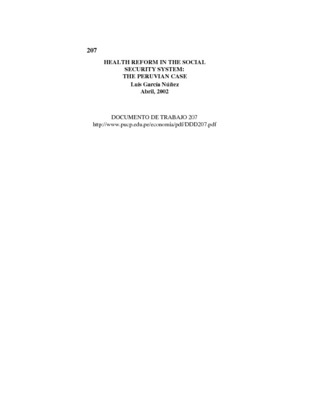| dc.contributor.author | García Núñez, Luis | |
| dc.date.accessioned | 2015-03-19T20:37:42Z | |
| dc.date.available | 2015-03-19T20:37:42Z | |
| dc.date.issued | 2002 | |
| dc.identifier.uri | http://repositorio.pucp.edu.pe/index/handle/123456789/46847 | |
| dc.description.abstract | Desde mediados de 1997 se ha implementado una reforma en la seguridad social en salud con el objetivo de mejorar la eficiencia en el sector, elevar la calidad de los servicios y extender la cobertura de la seguridad social a aquellos sectores poblacionales no cubiertos, todo dentro de un esquema de solidaridad y equidad. Sin embargo, después de más de tres años de su implementación, el sistema está aún lejos de cumplir sus objetivos. Las actuales estadísticas muestran que muchos peruanos no cuentan con un seguro de salud y que el actual esquema Público-Privado no es lo suficientemente amplio como para cubrir las necesidades de la población, especialmente los más pobres. Las compañías de seguros privadas (EPSs) aparentemente están orientadas a asegurar a trabajadores de empresas grandes, mientras que el seguro social de salud se estaría orientando a trabajadores de bajos ingresos. Otra característica de la reforma peruana es la escasa participación de las EPS en las provincias y su mínima participación en los seguros voluntarios. Estos hechos significarían que la reforma está aún muy lejos de alcanzar sus objetivos. | es_ES |
| dc.description.abstract | Since the middle of 1997, a health reform in the Peruvian social security system was implemented in order to improve the efficiency in the sector, to raise the quality of its services, and to extend its coverage to uncovered sectors, within a framework solidarity and equality. However, after almost three years of the implementation of this reform, the system is even further away from accomplishing these objectives. Current statistics show that many Peruvian citizens do not have a health insurance, and that the new Private-Public framework is not wide enough to cover the majority of the population, specially the poorest people. Private insurance companies (EPSs) seem to be oriented to insure large companies rather than small ones (the majority in Peru) while the public insurance would cover the low-income population. Other characteristics of the Peruvian reform are the scarce participation of these private insurance companies in the provinces and its minimum participation in voluntary insurance. Those facts would mean that the reform is still far away from accomplishing its objectives. | en_US |
| dc.language.iso | spa | es_ES |
| dc.publisher | Pontificia Universidad Católica del Perú. Centro de Investigaciones Sociológicas, Económicas, Políticas y Antropológicas - CISEPA | es_ES |
| dc.relation.ispartofseries | Documento de Trabajo;207 | es_ES |
| dc.rights | info:eu-repo/semantics/openAccess | es_ES |
| dc.rights.uri | http://creativecommons.org/licenses/by-nc-nd/2.5/pe/ | * |
| dc.subject | Seguridad social--Perú | es_ES |
| dc.title | Health reform in the social security system: the peruvian case | es_ES |
| dc.title.alternative | Reforma de la salud en el sistema de seguridad social: El caso peruano. | es_ES |
| dc.type | info:eu-repo/semantics/workingPaper | |
| dc.type.other | Documento de trabajo | |
| dc.subject.ocde | http://purl.org/pe-repo/ocde/ford#5.02.00 | |
| dc.publisher.country | PE | |
| renati.advisor.orcid | https://orcid.org/0000-0001-7674-5461 | |


